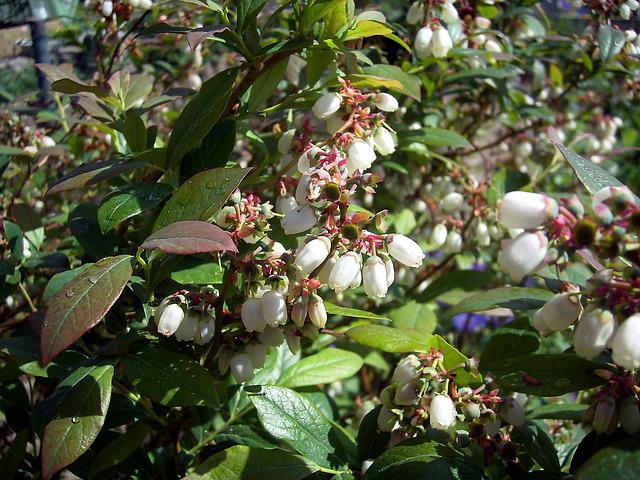Are Blueberries Self-Pollinating?

Blueberry plants have both a male and female reproductive organ. Male flowers in self-pollinating plants have the ability to release pollen onto female flowers. As a result, each flower can produce a blueberry by itself, without the assistance of any other flowers. Therefore, they are self-pollinating.
Naturally, self-pollination does not imply that pollination will be guaranteed. Although blueberries self-pollinate, pollinators (e.g.bees) are necessary to ensure the best possible harvest.
We’ll discuss blueberry self-pollination and the various varieties of blueberries in this article. Additionally, we’ll discuss cross-pollination and how bees can aid in the fruit production of blueberry plants.
Table of Contents
Do Blueberries Still Need Pollinators?
Self-pollination doesn’t imply that pollination will be guaranteed. For starters, the male part of the flower may not be able to release its pollen properly (especially in humid conditions). It is also possible that the pollen will not adhere to the female part of the flower (especially in dry conditions).
Most of the time, an external stimulus is required to aid in the pollination of self-pollinating flowers.
The stimulus could come from various sources, including wind, gravity, and pollinators.
Unfortunately, the first two items will not affect the development of blueberry flowers. Pollination by the wind or gravity is prevented as a result of this. As a result, blueberry plants must rely heavily on pollinators to produce fruit.
Blueberry plants can cooperate in pollinating each other. However, even though a single blueberry bush can produce fruit, the blueberry bush will produce more fruit and larger berries when other varieties of the same type are nearby.
The presence of two or more blueberry varieties of the same type within a short distance allows for cross-pollination.
Do Blueberries Require Cross-Pollination?
Cross-pollination occurs when pollen from one plant is used to pollinate another plant’s flowers. Planting two or more varieties of blueberries next to each other helps ensure cross-pollination.
No cross-pollination is necessary to produce fruit from a blueberry. Fruit can be produced entirely by a single plant without any outside help.
If you have other blueberry varieties nearby, you’ll get more fruit from your blueberry plants.
- Northern Highbush blueberries thrive in frigid weather for those who live in the north. At maturity, they can grow up to 7 feet tall.
- Unlike Northern Highbush varieties, Southern Highbush blueberries can’t withstand freezing temperatures. At full maturity, they can grow to a height of six feet.
- Lowbush blueberries, also known as wild blueberries, can be found on these bushes. Grown in Maine and Eastern Canada, they’re a popular choice. Because of their diminutive stature, they’ve been dubbed “one-footers.”
- Native to the Southeastern United States, Rabbiteye blueberry bushes produce delicious berries. In colder northern regions, they might not be able to consistently produce fruit. Other blueberry varieties are also less capable of self-pollination. At full maturity, they can grow up to 9 feet tall.
- These blueberry bushes, known as Half-High, are crossbreeds. Crossing Northern Highbush and Lowbush varieties produced them. Temperatures as low as -45 to -35°F are not a problem for them (-43 to -37°C). They can grow to heights of 3 to 4 feet at full maturity.
Is There a Benefit of Cross-Pollination?
- A More Even Ripening – the berries are more evenly and thoroughly ripened.
- Due to earlier pollination, berries tend to grow larger.
- As more flowers are pollinated, more fruits and vegetables are produced.
Is It Necessary to Plant Two Blueberry Plants to Get Fruit?
Two blueberry plants are not required for harvesting fruit. In theory, a single plant could pollinate itself and produce fruit. Because of this, it is best to plant multiple varieties of the same species together. Improved pollination and increased fruit production are two benefits of this strategy. More bees will pollinate other plants in your yard if you have more berries!
Are Bees Attracted to Blueberry Bushes?
Because of the large number of flowers on blueberry bushes, bees are attracted to them. According to the University of Florida Extension, many different pollinators can be found feeding on these flowers.
- Blueberry pollinators such as bumblebees
- Honeybees can compensate for their lack of efficiency with their large numbers.
- Blueberry Bees from the Southeast (common in Florida)
- Carpenter Bees are native wild bees (depending on where you live)
All of these bees may come to pollinate your blueberry bushes. Their effectiveness, on the other hand, can certainly vary.
To ensure that flowers are pollinated, honey bees must visit the same flower three times.
This is large because honeybees cannot perform “buzz pollination” (flower sounding). Pollen from flowers can be shaken loose by the vibrations caused by bumblebees’ wing and body movements.
Because honeybees are much smaller than bumblebees, they cannot have the same impact. These bees still put in the effort, and their large population makes up for their lower productivity.
Many blueberry flowers get pollinated in the first three days after they open. After six days, the chances of pollination go down dramatically.
Is Blueberry Pollination Reliant on Bees?
Bees are not required to pollinate blueberries. However, if you don’t give your plants a boost in pollination, you won’t be able to harvest much fruit. Bees will be able to collect pollen easier, which means more blueberry plants will be pollinated.
Wind pollination is possible for some plants. On the other hand, blueberry pollen is heavy, so it doesn’t travel far in the wind.
Blueberries’ pollination will be hampered if there are no bees or wind to help. The flowers will turn brown if they don’t receive enough pollination while still attached to the plant.
Insecticides or other problems may have adversely affected bee populations in your area. Despite this, there’s a chance.
